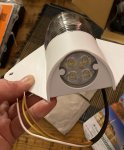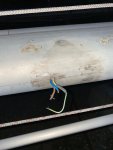MattS
Active member
I've bought an Osculati combined LED Steaming and Deck Light (Navigation and deck LED-light 12/24 V white body) and it comes with about 30cm of wires trailing out the back.

The unit appears to be sealed, so I'm assuming I'm not meant to be going in there and replacing with my own wire directly, but rather connecting the 30cm of provided wire to whatever wire I run up the mast.
Firstly, does this sound right?
Secondly - what would people recommend as the best method of connecting this?
I'm going to run new lighter 3-core anyway, given that the current draw on the LEDs will be much less than the previous light. Do I just use 3 solder seal wire connectors on the three cores to connect the two wires together, and then stick some large heat shrink tubing over the lot of them?
Sounds like it would end up being quite a bulky connection in the mast, and I guess would mean the weight of the wire up the mast would be hanging on that connection? How do I ensure the weight of the descending wire isn't just hanging off either these joints, or off their connections into the light itself?
Advice gratefully appreciated!

The unit appears to be sealed, so I'm assuming I'm not meant to be going in there and replacing with my own wire directly, but rather connecting the 30cm of provided wire to whatever wire I run up the mast.
Firstly, does this sound right?
Secondly - what would people recommend as the best method of connecting this?
I'm going to run new lighter 3-core anyway, given that the current draw on the LEDs will be much less than the previous light. Do I just use 3 solder seal wire connectors on the three cores to connect the two wires together, and then stick some large heat shrink tubing over the lot of them?
Sounds like it would end up being quite a bulky connection in the mast, and I guess would mean the weight of the wire up the mast would be hanging on that connection? How do I ensure the weight of the descending wire isn't just hanging off either these joints, or off their connections into the light itself?
Advice gratefully appreciated!


